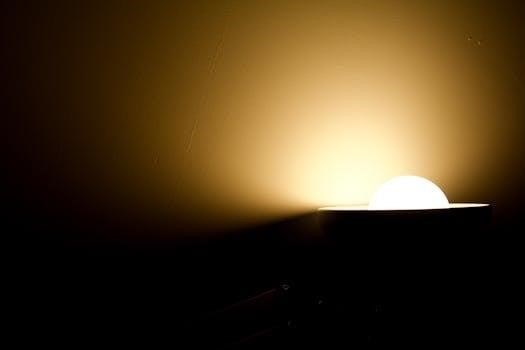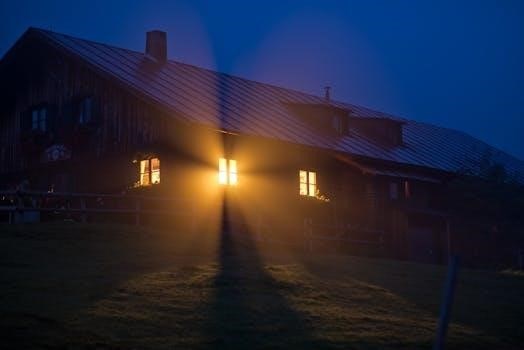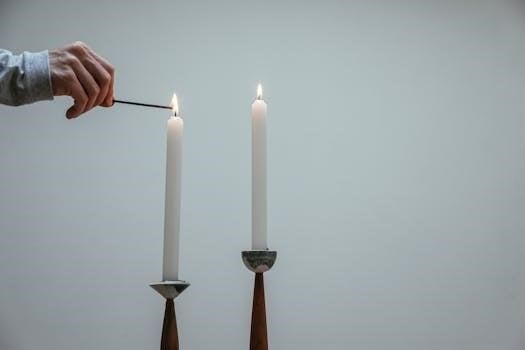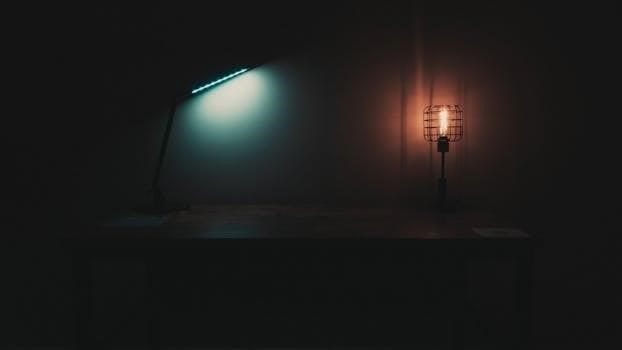Many commercially available night lights lack the personal touch and excitement of creating one yourself․ This guide explores crafting your own unique and comforting light source at home․
Why Create a DIY Night Light?
Embarking on a DIY night light project offers numerous advantages‚ moving beyond simple illumination․ It allows for complete customization‚ perfectly matching your room’s décor and personal preferences; Crafting your own night light provides a satisfying creative outlet‚ fostering a sense of accomplishment․ These projects are budget-friendly‚ often utilizing repurposed materials‚ making them a cost-effective alternative to store-bought options․ Additionally‚ they can be a fun and engaging activity for families‚ creating cherished memories and unique‚ handmade items․ A DIY night light adds a personal and heartfelt touch to any space‚ reflecting your unique style․

Materials and Tools
Gathering the right supplies is essential for a successful DIY night light․ This section outlines the basic materials and tools needed to get started․
Essential Supplies for DIY Night Lights
To embark on your DIY night light project‚ you’ll need a few key items․ Begin with an LED light source‚ known for its energy efficiency and low heat output‚ ensuring safety․ You’ll need a base material such as a wooden block‚ a repurposed teacup‚ or a mason jar․ Tracing paper or resin paper will be useful for creating shades․ Don’t forget essential adhesives like hot glue‚ plus wiring components if needed․ Finally‚ decorative elements like pressed flowers or glitter can add a personal touch․
Basic Night Light Construction
The foundation of your night light involves securely mounting the LED light source․ This may require using hot glue to affix the light to your chosen base element‚ like wood or glass․
Assembling a Simple LED Night Light
Begin by selecting a low-power LED light source‚ ensuring it’s suitable for enclosed spaces to prevent overheating․ Connect the LED to a power source‚ usually a battery pack or a USB connection‚ being mindful of polarity․ Secure the wiring using hot glue‚ ensuring no loose connections․ If using a wooden base‚ feed the wires through pre-drilled holes to keep them concealed․ A simple switch can be added inline for easy on-off functionality‚ making a practical and safe night light․

Creative Design Ideas
Explore various decorative approaches‚ such as incorporating pressed flowers or repurposing thrift store items․ The possibilities are endless for making a unique night light․
Using Pressed Flowers for Decoration
Transform your night light into a beautiful piece of art by using pressed flowers․ This technique involves carefully arranging dried flowers onto the surface of your light and securing them with a sealant like Mod Podge․ The result is a delicate and natural aesthetic‚ perfect for adding a touch of spring or summer to your room; This method is simple and visually stunning‚ making it a great option for both beginners and seasoned crafters․ It allows for a personalized and unique design that can be enjoyed both day and night․
Transforming Thrift Store Finds
Give new life to overlooked items by transforming thrift store treasures into unique night lights․ Teacups‚ sugar bowls‚ and other decorative pieces can be repurposed into charming luminaires․ This is a budget-friendly and eco-conscious way to create personalized lighting for your home․ The possibilities are endless‚ with each item bringing its own character to the finished project․ With some creativity‚ you can find a variety of interesting shapes and sizes that can serve as the base for your DIY night light‚ ensuring a truly one-of-a-kind result․

Advanced Techniques
Elevate your DIY night light with advanced methods like crafting resin paper shades for a unique translucent effect or integrating laser-cut wood elements for a modern touch․
Working with Resin Paper for Shades
Creating shades with resin paper offers a unique way to personalize your DIY night light․ This technique involves using resin to encapsulate paper‚ creating translucent and durable covers․ This method is a fun project that allows for creative expression through color and texture․ You can add glitter or food coloring to the resin to create a custom color palette for your light․ The resulting shade will give your night light a distinctive‚ artistic appearance․ This is perfect for adding a personal touch to any room․
Integrating Wood and Laser Cut Elements
Incorporating wood and laser-cut designs brings a natural and detailed aesthetic to your DIY night light․ Laser cutting allows for intricate patterns and shapes to be created on wood‚ which can then be used as a base or shade for the light․ Unfinished wood blanks provide a great base for custom designs‚ and you can add unique patterns‚ or even personalized text using laser cutting tools․ This combination of natural material and precise cutting creates a modern and stylish look that complements any room’s décor․

Powering Your Night Light
Powering your DIY night light requires careful attention to wiring‚ ensuring safe connections to a power source․ Use appropriate wiring techniques to avoid any hazards or risks․
Safe Wiring Practices
When working with electricity‚ prioritize safety above all else․ Always disconnect the power source before beginning any wiring work․ Use appropriate gauge wires suitable for the intended load of the LED or light source․ Ensure all connections are secure‚ using heat shrink tubing or electrical tape to insulate exposed wires; If you are unsure about any part of the wiring process‚ it’s best to seek assistance from a qualified electrician to avoid potential hazards and ensure safe operation․ Double-check all wiring before applying power․
Safety Considerations
Proper ventilation around the light source is important to prevent overheating․ Always check for any potential fire hazards‚ and use fire resistant materials when crafting your night light․
Preventing Overheating Issues
When creating your DIY night light‚ it is crucial to prioritize safety to prevent overheating․ LEDs are generally safer than older incandescent bulbs‚ but still require consideration․ Ensure adequate ventilation around the light source by not fully enclosing it․ If using an ornament or decorative piece‚ consider cutting openings to allow heat to escape․ Monitor the temperature of your night light‚ especially during extended use․ Avoid using materials that can easily ignite or trap heat․ Opt for a low-wattage LED to reduce the risk of heat buildup․ Always supervise your DIY night light and unplug it if it becomes too hot․
Troubleshooting and Maintenance
If your DIY night light stops working‚ first check the power source and wiring connections․ For LED issues‚ ensure proper polarity․ Clean the light regularly to avoid dust buildup․
Addressing Common Problems
A frequent issue with DIY night lights is inconsistent illumination‚ often due to poor wiring or loose connections․ Check all soldered joints or wire nuts for secure contact․ If using an LED‚ ensure the correct polarity is maintained; LEDs only work in one direction․ Overheating can occur if the light source is enclosed without adequate ventilation; consider adding air gaps․ If your light flickers‚ the power supply might be unstable or the LED may be failing․ Always ensure that all components are rated for the correct voltage and current to prevent damage and maintain safety․
